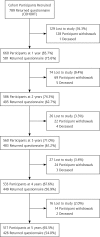Self-rated health and long-term prognosis of depression
- PMID: 24445104
- PMCID: PMC3896539
- DOI: 10.1370/afm.1562
Self-rated health and long-term prognosis of depression
Abstract
Purpose: Indicators of prognosis should be considered to fully inform clinical decision making in the treatment of depression. This study examines whether self-rated health predicts long-term depression outcomes in primary care.
Methods: Our analysis was based on the first 5 years of a prospective 10-year cohort study underway since January 2005 conducted in 30 randomly selected Australian primary care practices. Participants were 789 adult patients with a history of depressive symptoms. Main outcome measures include risks, risk differences, and risk ratios of major depressive syndrome (MDS) on the Patient Health Questionnaire.
Results: Retention rates during the 5 years were 660 (84%), 586 (74%), 560 (71%), 533 (68%), and 517 (66%). At baseline, MDS was present in 27% (95% CI, 23%-30%). Cross-sectional analysis of baseline data showed participants reporting poor or fair self-rated health had greater odds of chronic illness, MDS, and lower socioeconomic status than those reporting good to excellent self-rated health. For participants rating their health as poor to fair compared with those rating it good to excellent, risk ratios of MDS were 2.10 (95% CI, 1.60-2.76), 2.38 (95% CI, 1.77-3.20), 2.22 (95% CI, 1.70-2.89), 1.73 (95% CI, 1.30-2.28), and 2.15 (95% CI, 1.59-2.90) at 1, 2, 3, 4, and 5 years, after accounting for missing data using multiple imputation. After adjusting for age, sex, multimorbidity, and depression status and severity, self-rated health remained a predictor of MDS up to 5 years.
Conclusions: Self-rated health offers family physicians an efficient and simple way to identify patients at risk of poor long-term depression outcomes and to inform therapeutic decision making.
Keywords: depression; longitudinal study; primary care; prognosis; self-rated health.
Figures


Similar articles
-
Development of a prognostic model for predicting depression severity in adult primary patients with depressive symptoms using the diamond longitudinal study.J Affect Disord. 2018 Feb;227:854-860. doi: 10.1016/j.jad.2017.11.042. Epub 2017 Nov 13. J Affect Disord. 2018. PMID: 29689701
-
Self-rated health: a predictor for the three year incidence of major depression in individuals with Type II diabetes.J Affect Disord. 2013 Feb 15;145(1):100-5. doi: 10.1016/j.jad.2012.07.018. Epub 2012 Aug 14. J Affect Disord. 2013. PMID: 22902269
-
What factors influence long-term antidepressant use in primary care? Findings from the Australian diamond cohort study.J Affect Disord. 2015 May 1;176:125-32. doi: 10.1016/j.jad.2015.01.055. Epub 2015 Feb 2. J Affect Disord. 2015. PMID: 25704565
-
Indicators of self-rated health in the Canadian population with diabetes.Diabet Med. 2012 Aug;29(8):1021-8. doi: 10.1111/j.1464-5491.2012.03571.x. Diabet Med. 2012. PMID: 22248314
-
Psychosocial interventions for preventing and treating depression in dialysis patients.Cochrane Database Syst Rev. 2019 Dec 2;12(12):CD004542. doi: 10.1002/14651858.CD004542.pub3. Cochrane Database Syst Rev. 2019. PMID: 31789430 Free PMC article.
Cited by
-
Effects of Wisdom on Mental Health in Old Age: Exploring the Pathways Through Developmental Tasks Attainment and Self-Rated Health.Psychol Res Behav Manag. 2023 Nov 3;16:4541-4554. doi: 10.2147/PRBM.S429918. eCollection 2023. Psychol Res Behav Manag. 2023. PMID: 37942442 Free PMC article.
-
Frequent attenders in the German healthcare system: determinants of high utilization of primary care services. Results from the cross-sectional German health interview and examination survey for adults (DEGS).BMC Fam Pract. 2020 Jan 13;21(1):10. doi: 10.1186/s12875-020-1082-9. BMC Fam Pract. 2020. PMID: 31931727 Free PMC article.
-
Trends of healthy and unhealthy working life expectancy in Germany between 2001 and 2020 at ages 50 and 60: a question of educational level?J Epidemiol Community Health. 2023 Jul;77(7):430-439. doi: 10.1136/jech-2023-220345. Epub 2023 May 16. J Epidemiol Community Health. 2023. PMID: 37193584 Free PMC article.
-
Burnout syndrome among preschool teachers in Serbia.Arh Hig Rada Toksikol. 2024 Jun 29;75(2):116-124. doi: 10.2478/aiht-2024-75-3825. eCollection 2024 Jun 1. Arh Hig Rada Toksikol. 2024. PMID: 38963143 Free PMC article.
-
Association between Soft-Drink Intake and Obesity, Depression, and Subjective Health Status of Male and Female Adults.Int J Environ Res Public Health. 2021 Oct 3;18(19):10415. doi: 10.3390/ijerph181910415. Int J Environ Res Public Health. 2021. PMID: 34639714 Free PMC article.
References
-
- World Health Organization (WHO) The Global Burden of Disease: 2004 Update. Geneva, Switzerland: World Health Organization; 2008
-
- Bloom DE, Cafiero ET, Jané-Llopis E, et al. The Global Economic Burden of Non-communicable Diseases. Geneva, Switzerland: World Economic Forum; 2011
-
- Australian Bureau of Statistics National Survey of Mental Health and Wellbeing: Summary of Results, 2007. Canberra, Australia; 2007
-
- Herrman H, Patrick DL, Diehr P, et al. Longitudinal investigation of depression outcomes in primary care in six countries: the LIDO study. Functional status, health service use and treatment of people with depressive symptoms. Psychol Med. 2002;32(5):889–902 - PubMed
-
- Cassano P, Fava M. Depression and public health: an overview. J Psychosom Res. 2002;53(4):849–857 - PubMed
Publication types
MeSH terms
LinkOut - more resources
Full Text Sources
Other Literature Sources
Medical
Research Materials
Miscellaneous
